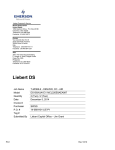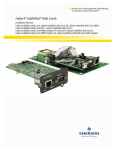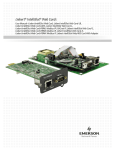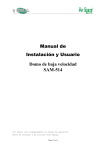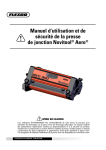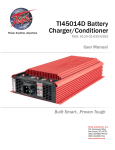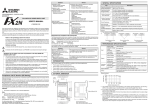Download Emerson Liqui-tect MC68HC16Z1 Installation manual
Transcript
Infrastructure Management & Monitoring For Business-Critical Continuity™ Liebert Liqui-tect® 460 Installation Manual - Zone Leak Detection Sensor TABLE OF CONTENTS INTRODUCTION . . . . . . . . . . . . . . . . . . . . . . . . . . . . . . . . . . . . 1 EXTERIOR DIMENSIONS AND MOUNTING DETAILS. . . . . . . . . . . 1 PLACEMENT ON SUBFLOOR UNDER COOLING SUPPORT EQUIPMENT . . . . . . . . . . . . . . . . . . . . . . . . . . . . . . . . . . . . . . 2 POWER WIRING . . . . . . . . . . . . . . . . . . . . . . . . . . . . . . . . . . . 3 WIRING TO AUXILIARY ALARM PANELS . . . . . . . . . . . . . . . . . . 4 CONFIGURATION SWITCH SETTINGS . . . . . . . . . . . . . . . . . . . . 5 Leak Detect Filter Delay(SS1) . . . . . . . . . . . . . . . . . . . . . . . . . . 5 Latching or Non-Latching Alarms (SS2) . . . . . . . . . . . . . . . . . . 5 Alarm Retest Delay (SS3) . . . . . . . . . . . . . . . . . . . . . . . . . . . . . . 6 LED OPERATION . . . . . . . . . . . . . . . . . . . . . . . . . . . . . . . . . . 7 NOTES . . . . . . . . . . . . . . . . . . . . . . . . . . . . . . . . . . . . . . . . . . 7 INSTALLATION OF LEAK DETECTION SYSTEM CABLE . . . . . . . . 8 LEAK DETECTION KIT INSTALLATION SCENARIOS . . . . . . . . . 10 i ii Introduction Liebert Liqui-tect® Leak Detection Sensors install quickly and work simply for reliable detection of conductive aqueous fluid leaks. The Liqui-tect 460 Sensor provides zone protection using the easy-toinstall and quick-drying Liebert leak detection cable. LEDs located on the top cover of the module provide visual indication. A reset button provides optional manual acknowledgement of alarms. The top cover is hinged, allowing easy access to the electronics housed inside the steel enclosure. Terminal blocks allow easy interconnection of power and alarm outputs. Dual Form-C relay outputs can simultaneously signal the local alarm panel and remote monitoring system. The Liqui-tect 460 Sensor features supervised operation through alarms for cable faults, circuit failure or loss of power, ensuring a completely self-monitored leak detection system. The LT460 is conveniently available in packaged kits with 20, 25, 30, 35 or 45 feet of leak detection cable and hold-down clips. Note that additional cable cannot be added to packaged kits. The LT460 sensor can also be purchased independently. The sensor can accommodate up to 100 feet of leak detection cable if the sensor and leak detection cables are purchased as independent components. Exterior Dimensions and Mounting Details TOP VIEW 4.75" (120.65mm) FRONT VIEW 4.25" (108mm) Leak detection cable connector Form-C relay outputs & power wiring connection 3.25" (83mm) 4.75" (121mm) Shipping weight: 2 Ibs (0.9 kg) Mounting holes: #8 screws 1 2" (51mm) Placement on Subfloor Under Cooling Support Equipment (Other applications such as long perimeter walls can be monitored) To a Liebert environmental unit and an optional* monitoring panel To external power supply or directly from unit (see Power Wiring on page 3) Leak detection cable Leak detection zone (directly beneath unit) LT460 * Output connections to external alarm monitoring panels such as the Liebert contact closure alarm panels As shown above, the Liqui-tect 460 (LT460) may be placed on a subfloor, where it is connected to the leak detection cable that surrounds the leak detection zone—the area directly beneath the unit being protected or other areas such as the perimeter of a room. Note: For a downflow unit, the leak detection cable must be located six feet in front of the unit. The LT460 requires a 24 VAC power supply either from the environmental unit or an external source. There are two sets of Form-C dry contacts for connection to a Liebert environmental unit and an external monitoring panel. For more information: • See Installation of Leak Detection System Cable on page 8 for instructions on installing the cable and proper placement of the hold-down clips. • See Leak Detection Kit Installation Scenarios on page 10 for cable placement, distance from the unit, and part numbers. 2 Power Wiring The LT460 is rated for 24 VAC, 50/60 Hz and 0.12 amp. Figure 1 24V from Liebert environmental units to LT460 Challenger, Himod or Liebert Deluxe System/3, MM2DS, (8 Ton) LT460 Challenger, Himod or Mini-Mate2 (8 ton) LT460 TB1 TB1 TB1 TB1 T5 (24V) T5 (24V) TB1-1 TB1-1 G5 (Ground) (Ground) G5 TB1-2 TB1-2 Liebert MM2 (1 to 5 Ton) LT460 TB1 Power Wiring 4V transformer of (24V) here are no ated terminal 24V(Ground) from Liebert tions) TB1-1 Environmental Unit to LT460 Liebert Deluxe Sys/3, 24V fromHimod Transformer Challenger, or MM2 (8 Ton) T5 (24V) connection on Liebert unit to LT460 LT460 LT460 Transformer TB1 TB1 TB1 T5 (24V) G5 TB1-2 Location of From 24V transformer (Ground) MM2 (1 to(15 to Ton) LiebertLiebert Mini-Mate2 5 ton) TB1-1 TB1-1 TB1-2 TB1-2 LT460 LT460 TB1 TB1 4V transformer of (24V) here are no From 24V ated terminal transformer* (Ground) tions) TB1-1 TB1-1 TB1-2 TB1-2 * Requires a 24V external transformer (there are no designated terminal connections on the unit) Figure 2 24V from Transformer to LT460 24V from transformer to LT460 Transformer Transformer LT460 LT460 TB1 TB1 TB1-1 TB1-1 From 24V24V From transformer transformer TB1-2 TB1-2 3 Wiring to Auxiliary Alarm Panels The LT460 has two Form-C dry contact alarm output contacts (TB2 & TB3). Each contact is rated for 24 VAC at 3 amp. Figure 3 LT460 to Liebert environmental units Liebert Deluxe Sys/3, Challenger, Himod or MM2Liebert (8 Ton) DS LT460 LT460 TB2 Environmental Env.unit Unit TB2-3 (N.C.) (N.C.) TB2-3 TB2-2 (C) (C) TB2-2 (24V) 24 (24V) TB2-1 (N.O.) (N.O.) TB2-1 50, 51, 55 or 56 51 LT460 Liebert Deluxe System/3, Liebert MM2 (1 to 5 Ton)or Challenger, Himod Mini-Mate2 (8 ton) LT460 TB2 Environmental Env.unit Unit TB2-3 (N.C.) (N.C.) TB2-3 TB2-2 (C) (C) TB2-2 24 (24V) TB1-1 (24V) TB2-1 TB2-1 (N.O.) (N.O.) TB1-2 51, 55 or 56 LT460 LT460 TB2 TB2 OR Liebert MM2 (1 to 5 Ton) Liebert Mini-Mate2 (1 to 5 ton) Environmental Env.unit Unit TB2-3 (N.C.) (N.C.) TB2-3 TB2-2 (C) (C) TB2-2 TB1-1 (24V) (24V) TB2-1 (N.O.) (N.O.) TB2-1 TB1-2 or TB1-3 TB1-3 Figure 4 LT460 to Liebert contact monitor panel LT460 LT460 Liebert Contact Liebert contact Monitor Panel monitor panel TB2 TB2-3(N.C.) (N.C.) TB2-3 Alarm panel Panel Input contact Contact (N.O.) (N.O.) TB2-2(C) (C) TB2-2 TB2-1(N.O.) (N.O.) TB2-1 4 Configuration Switch Settings A four-position DIP switch is used to select two alarm (filter) delays and three mutually exclusive alarm modes. The switches are located next to the wiring termination blocks. 1. 2. 3. 4. Leak Detect Filter Delay(SS1) Contacts Rating: Switch Settings Leak Detect Filter Alarm Latch Alarm Retest Delay Not Used S1 OFF ON 10sec 2min No Yes No 1hr — — ALL CIRCUITS: CLASS 2 Contacts shown in POWERED, NON-ALARM state 24V,3A TB3-3 TB3-2 TB3-1 N.C. C 2 N.O. SS1 selects the leak detect filter N.C. TB2-3 delay, the interval for which a leak Contacts C Rating: TB2-2 condition must be continuously 1 24V,3A TB2-1 N.O. detected before an alarm is 24V triggered: TB1-2 50/60Hz TB1-1 OFF = 10 seconds (default) 0.12A ON = 2 minutes CONNECT ENCLOSURE TO EARTH GROUND This feature is useful for eliminating nuisance alarms. SS1 works independently of the settings of SS2 and SS3. While the alarm delay is selectable (factory default is OFF=10 seconds), the cable fault delay is preset at approximately 2 seconds. Latching or Non-Latching Alarms (SS2) SS2 selects latching or non-latching alarms, the setting in which an alarm will latch ON until manually reset: OFF = Non-latching (default) ON = Latching The factory default is OFF=Non-latching. If the sensor is in latching mode (ON=Latching) and the leak condition clears itself in the interim, a manual reset is required. While the alarm is latched, the sensor goes into a “sleep” mode and power to the leak detection cable is discontinued. De-powering the cable prevents damage to the cable should it be in contact with the conductive liquid for an extended duration. After a manual reset, the sensor resumes its normal operation, continuously checking for leaks. If the leak condition has not yet cleared but the sensor is manually reset, the sensor will re-alarm after the appropriate leak detect filter delay. SS2 in the ON position will disable the operation of SS3. 5 Alarm Retest Delay (SS3) SS3 selects the alarm retest delay, the setting in which an alarm is latched and retested every hour. OFF = Non-latching (default) ON = Latching-retest each hour The factory default is OFF=Non-latching. If SS3=ON and a leak is detected, the alarm condition is latched, the sensor goes into a “sleep” mode and power to the leak detection cable is discontinued. After one hour, the sensor will automatically retest if the leak is still present. If the leak has cleared itself, the sensor deactivates the alarm, resets itself and resumes normal operation; if the leak is still present, the alarm condition remains activated and the sensor goes to “sleep” and retests in another hour. This procedure will repeat indefinitely until the leak is cleared or until the alarm is manually reset. A manual reset can be initiated at any time. If the leak condition has not yet cleared, the sensor re-alarms after the selected leak detect filter delay; if the leak has cleared, the sensor deactivates the alarm and resets itself. SS3 is disabled if SS2=ON. The factory default settings of SS2=OFF and SS3=OFF place the sensor in a non-latching, continuous retest mode. The sensor does not go to “sleep” after detecting a leak—instead, it continually checks to determine whether the leak condition has cleared itself. Alarms automatically reset when the leak condition clears. Initiating a manual reset will cause the sensor to trigger the alarm again after the selected leak detect filter delay. The leak detect cable remains powered at all times. SS4 is not used. SS1 SS2 SS3 SS4 MODE OFF OFF OFF (not used) Non-latching, 10-second filter delay (factory default) ON OFF OFF (not used) Non-latching, 2-minute filter delay OFF ON — (not used) Latching, 10-second filter delay ON ON — (not used) Latching, 2-minute filter delay OFF OFF ON (not used) 1-hour latch/retest, 10-second filter delay ON OFF ON (not used) 1-hour latch/retest, 2-minute filter delay 6 LED Operation Liqui-tect® Sensor LT460 System Normal Alarm Pending Leak Detected Reset Cable Fault System Normal (Green): • ON continuously when power is applied to sensor. Alarm Pending (Yellow): • ON continuously during leak detect filter delay and cable fault delay. • FLASHING (with Leak Detected LED) to indicate cable fault condition. Leak Detected (Red): • FLASHING to indicate leak detected alarm. • FLASHING (with Alarm Pending LED) to indicate cable fault condition. Notes This equipment has been tested and found to comply with the limits for a Class A digital device, pursuant to part 15 of FCC rules. These limits are designed to provide reasonable protection against harmful interference when the equipment is operated in a commercial environment. This equipment generates, uses, and can radiate radio frequency energy and, if not installed and used in accordance with the instruction manual, may cause harmful interference to radio communications. Operation of this equipment in a residential area is likely to cause harmful interference in which case the user will be required to correct the interference at his own expense. In the event of a severe leak causing submersion or partial-submersion of the enclosure and/or the electronic circuitry inside the enclosure, the entire module should be returned to the factory for inspection. 7 Installation of Leak Detection System Cable 1. Attach the leak detection cable to the LT460 module. 2. Activate module and test detection cable. (Touch detection cable with a clean moist cloth or paper towel.) Dry detection cable to remove the alarm condition. (A hair dryer can be used to speed up the drying.) Note: Do not try to saturate the detection cable for testing! It only requires a small amount of water to alarm. The detection cable will have to dry for the alarm condition to clear. DETECTION CABLE PLACEMENT PRECAUTIONS • Do not use detection cable that is damaged or dirty—for example, from plaster, spackle or construction debris. • Detection cable should not be dragged through contaminants (dirty or greasy areas). Floor must be clean for the detection cable to function properly and for the hold-down clips to adhere to the floor surface. • Careful consideration should be taken to place detection cable out of the direct discharge airflow path of environmental equipment. This type of equipment can discharge moisture into the airflow. Place cable six feet from discharge to avoid nuisance alarms during humidification. • Tools or heavy objects can do permanent damage when dropped, rolled, or set on the detection cable. Avoid foot traffic on the detection cable as well. • Do not use any type of adhesive tapes to secure the detection cable. • Do not allow soldering or welding near the detection cable without providing protection from heat or contaminants. (Also avoid installing the detection cable in or near these type of areas.) • Mild dishwashing liquid can be used to clean the detection cable of many contaminants. 3. Once the cable passes the test, lay it in the pattern desired. 8 4. The installation of the hold-down clips should be in pairs according to Figure 5 with the following considerations: Figure 5 Installation of hold-down clips in pairs a. One pair every 6 to 8 feet in straight patterns (see Figure 6). b. One pair every 3 to 4 feet in circular patterns (see Figure 7). c. One pair at the beginning and end of the arc when turning 90 degrees (see Figure 8). d. One pair as needed to maintain consistent uniform contact between the floor and detection cable. Figure 6 Cable laid in straight patterns Figure 7 Cable laid in circular patterns Hold-down clips every 3-4 ft. Hold-down clips every 6-8 ft. Figure 8 90° turn in cable Hold-down clips at beginning & end of arc 5. Be certain the detection cable is protected from the adhesive installation for the hold-down clips. No adhesive should come in contact with the detection cable. 6. Once adhesive is completely dry, snap the cable into each hold-down clip. 7. Check that there are no gaps between the floor and detection cable. (Add clips as required.) 8. Be certain there are no alarms present on the module. 9. Do final testing as per instruction in Step 2. 9 Leak Detection Kit Installation Scenarios Scenarios Upflow Unit Upflow Unit Detection around entire unit Detection on sides and in front of unit 2-ft clearance in front 2-ft clearance in front Downflow Unit Downflow Unit Detection around entire unit Detection on sides and in front of unit 6-ft clearance in front 6-ft clearance in front Distance from unit Distance: In back On sides In front 2 ft 2 ft 2 ft No cable behind 2 ft 2 ft Unit 1 ft 1 ft 6 ft No cable behind 1 ft 6 ft Part number (footprint-in.) Challenger (32.5 x 32.5) LT460-Z30 LT460-Z20 LT460-Z30 LT460-Z25 LT460-Z35 LT460-Z20 LT460-Z35 LT460-Z25 (50 x 35) LT460-Z30 LT460-Z20 LT460-Z35 LT460-Z25 (74 x 35) LT460-Z35 LT460-Z20 LT460-Z35 LT460-Z25 Himod (69 x 35) Deluxe System/3 (99 x 35) LT460-Z45 LT460-Z25 LT460-Z45 LT460-Z30 (122 x 35) LT460-Z45 LT460-Z25 LT460-Z45 LT460-Z30 (73 x 35) LT460-Z35 LT460-Z20 LT460-Z45 LT460-Z30 (86 x 35) LT460-Z35 LT460-Z20 LT460-Z45 LT460-Z30 DS (98 x 35) LT460-Z45 LT460-Z25 LT460-Z45 LT460-Z30 (109 x 35) LT460-Z45 LT460-Z25 LT460-Z45 LT460-Z30 (132 x 35) LT460-Z45 LT460-Z25 LT460-Z45 LT460-Z30 10 Ensuring The High Availability Of Mission-Critical Data And Applications. Technical Support / Service Web Site www.liebert.com Monitoring [email protected] 800-222-5877 Outside North America: +00800 1155 4499 Single-Phase UPS & Server Cabinets [email protected] 800-222-5877 Outside North America: +00800 1155 4499 Three-Phase UPS & Power Systems 800-543-2378 Outside North America: 614-841-6598 Environmental Systems 800-543-2778 Outside the United States: 614-888-0246 Locations United States 1050 Dearborn Drive P.O. Box 29186 Columbus, OH 43229 Europe Via Leonardo Da Vinci 8 Zona Industriale Tognana 35028 Piove Di Sacco (PD) Italy +39 049 9719 111 Fax: +39 049 5841 257 Asia 29/F, The Orient Square Building F. Ortigas Jr. Road, Ortigas Center Pasig City 1605 Philippines +63 2 687 6615 Fax: +63 2 730 9572 While every precaution has been taken to ensure the accuracy and completeness of this literature, Liebert Corporation assumes no responsibility and disclaims all liability for damages resulting from use of this information or for any errors or omissions. © 2010 Liebert Corporation All rights reserved throughout the world. Specifications subject to change without notice. ® Liebert is the registered trademark of Liebert Corporation. All names referred to are trademarks or registered trademarks of their respective owners. SL-31045_REV5_12-11 Emerson Network Power. The global leader in enabling Business-Critical Continuity™ EmersonNetworkPower.com AC Power Outside Plant Connectivity Power Switching & Controls DC Power Precision Cooling Embedded Computing Racks & Integrated Cabinets Embedded Power Services Infrastructure Management & Monitoring Surge Protection Emerson, Business-Critical Continuity, Emerson Network Power and the Emerson Network Power logo are trademarks and service marks of Emerson Electric Co. or one of its affiliated companies. ©2010 Emerson Electric Co.
















